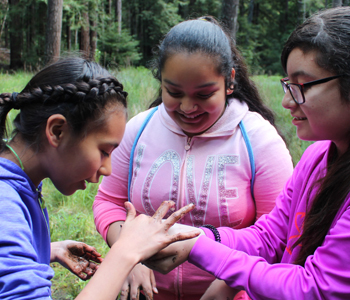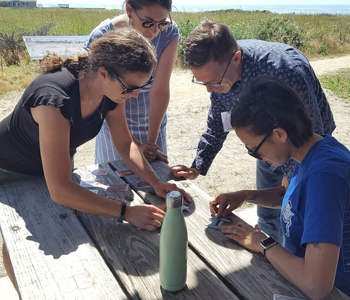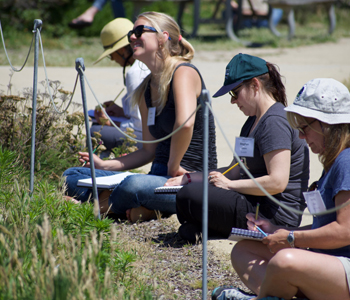Environmental Literacy May Be the Answer
By Amity Sandage
Across the state at science education events, environmental literacy is increasingly in the spotlight. At the opening of the CSTA conference, after the Climate Summit, high school teachers were so eager to get more resources that some sessions were beyond full—teachers were finding space on the floor. In addition to CSTA offerings, the California Environmental Literacy Initiative, CA NGSS Statewide Rollout: Environmental Literacy and regional California Environmental Phenomenon Summits are giving administrators and teachers rich learning opportunities and resources that use environmental literacy to support existing education goals and standards.
Why all the buzz? There are multiple reasons why this is exciting news for our schools.
- For the first time since the adoption of Common Core and NGSS, our education system is unifying around a common context that provides natural integration across all subject areas and science domains.
- The natural and built environment provides intriguing, natural phenomena to explore as teachers are shifting from demonstrating science concepts that students should “know” to engaging students in the NGSS Science and Engineering Practices to examine and construct their own explanations.
- Real world, local environmental issues are motivators for students as they apply what they are learning in the curriculum and work to engineer solutions.
- We are providing education that is essential for the next generation—students who are faced with mitigating the effects of human systems on natural systems to ensure a viable future for people and the planet.


A movement this big is exciting but can also be daunting. Connecting NGSS to environmental literacy makes sense, but how are districts approaching this in systemic ways? Who is providing resources to connect to local contexts? What does this look like in the classroom?
Districts can leverage the integration of environmental literacy to support many of their existing goals—as outlined in this Call to Action for County, District and Education Leaders provided by the California Environmental Literacy Initiative (CAELI). District leaders will find that environmental literacy can be integrated through a variety of pathways, depending on the existing priorities of the district. Entry points typically fall within one of three pillars: Curriculum, Facilities and Community.
A Curriculum Approach
Identifying local environmental connections to curriculum and giving students opportunities to get outside the classroom allows them to apply what they are learning. This is key to making the curriculum more engaging and more relevant to students’ lived experiences. For example, Santa Cruz City School District partners with their local water department to provide field trips to all 5th grades in the district to visit the water treatment and storage facilities for their city. The trip is part of a series of classroom lessons that connect to grade level NGSS curriculum. Another district, Pajaro Valley Unified School District adopted local environmental themes—agriculture, watershed and ocean—to highlight in the curriculum and connect to outdoor experiences. The goal is to make learning more culturally relevant and to encourage building deeper content knowledge within those topics as NGSS spirals through K-12.
A Facilities Approach
For some schools or districts, “greening” schools through waste reduction, energy efficiency, water conservation and other sustainability efforts is a win-win for the district business office, for the school community and for the planet. At Scotts Valley Unified School District, the high school took advantage of new construction by engaging students in designing and implementing new landscaping for all areas of the campus. This has led to spaces that invite students to gather outdoors and hang out amidst unique drought tolerant plantings. A new grant and local partner will support students in the coming school year to revise their plantings as they study native plant communities in a nearby open space, and re-envision the campus as an extension of habitat for local flora and fauna.
In addition to increasing green spaces on campuses, several districts in the county have also changed their food systems to eliminate single use plastics and explore share tables in preparation to meet new waste reduction requirements from the state. Food waste is a major contributor to carbon footprints. To further reduce greenhouse gas emissions, districts have also changed school drop-off and pick-up procedures and instituted bans on car idling. These types of sustainability efforts are excellent opportunities to engage students in data collection and analysis, to estimate reductions in carbon emissions, and to model impacts of different scenarios.


A Community Approach
The community-based approach to integrating environmental literacy often includes the curriculum connections and greening of schools described above, but combines them with an essential additional ingredient: community partners. As teacher leaders in Santa Cruz County have been diving deep into Next Generation Science Standards, they have been connecting them to local environments and community-based field programs.
During professional learning programs, teachers and community partners from local environmental organizations learn together about NGSS and collaborate during field science investigations and lesson planning sessions. So far, over 150 teacher leaders representing nearly every school site in the county have worked together with environmental educators from local organizations who support schools by connecting NGSS-based science lessons to outdoor programs that make student learning more meaningful, exciting and personal. The result? Below are teachers’ descriptions of the benefits to students they saw when incorporating environmental literacy and outdoor learning with community partners into their implementation of NGSS:
“Students practiced thinking skills, writing skills, inquiry skills, nature journaling, integrated field trips – [and got] time to go in depth and revisit, to elaborate and grow our understanding.” ~3rd Grade Teacher
“As unexpected things occur now in my classroom or in the greater community that my students or I notice, we address them as phenomena and explore the ideas, questions, and understandings we have to develop explanations and explorations around these topics. We don't just move on, or ignore, or have someone explain to us. We are behaving more as scientists and less as information consumers now. ” ~4th Grade Teacher
“Student understanding shifted from the basic concept of food webs to the deeper richer concept of energy moving through and ecosystem.” ~5th Grade Teacher
“With a more thorough understanding of Next Generation Science Standards, I think I taught better. I also brought way more nature into the classroom. It changed their [students] ideas about what science is outside the classroom everyday. I also think doing environmental volunteering impacts their lives a lot.” ~Middle School Teacher
“They were able to confront a phenomenon, do the actual field work needed to explain that phenomenon, and then apply the trends they discovered to novel situations - modeling what a core conceptual knowledge base can allow them to do later in life.” ~High School Teacher
“Making connections to our local ecosystems has resulted in so much more student engagement with the science content. Students come to class each day sharing observations about their community that relate to what we have learned.” ~High School Teacher
The natural fit between NGSS and environmental literacy gives students the opportunity to learn, feel inspired and have a positive impact on the world. And it is really just the beginning of this revolution.
Next up: Environmental literacy and history-science, social emotional learning and health!
Amity Sandage serves as Environmental Literacy Coordinator for Santa Cruz County Office of Education, leading a strategic countywide effort to build environmental literacy of all students in the public education system.
Author note: As the environmental literacy coordinator for Santa Cruz County Office of Education, I get to see this work first hand in a variety of settings. Above are a few examples of what districts are doing in Santa Cruz County, where we have a countywide effort to integrate environmental literacy and implementation of new standards, and there are other counties and districts, urban and rural, in the north and south, who are doing amazing work in this arena. Keep in mind, your own school or district approach will be unique and right for you and your students.
To connect, visit the Santa Cruz COE Environmental Literacy for All website or https://www.santacruzcoe.org/education-services/environmental-programs/




